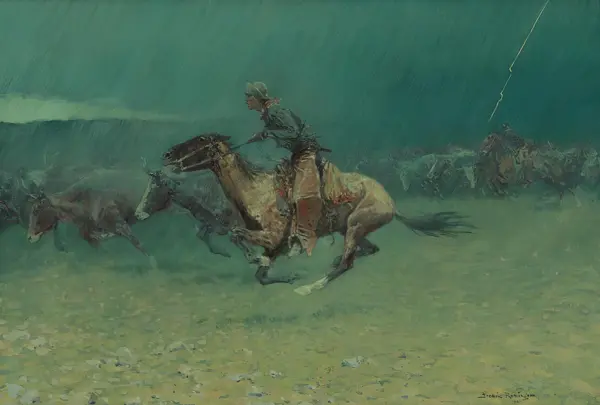About this finishing
Print. The image is printed on the top quality 10-ink HP Z9PS printer on HP matte 270 g / m2 paper. You can choose any size to an accuracy of 1 cm. A margin of 5 cm around the image is added to the size of the motif.


You can find a detailed description about our finishings
here.
The Stampede
Date:
1908Medium:
oil on canvasLocation:
Gilcrease MuseumDimensions:
100 x 67 cm Remington painted picture The Stampede in 1908. Prevailing color of this fine art print is brown and its shape is landscape. Original size is 100 x 67 cm. This art piece is located in Gilcrease Museum. This image is printed on demand - you can choose material, size and finishing.
Frederick Sackrider Remington (1861-1909) was an American painter and illustrator representing the artistic direction of
Realism, with which he captured the old American West. He was born in New York to a family of a colonel and active Republican. The history of his family is rich and its roots go deep:
George Catlin, a painter of American Indians and collector of their artefacts, was his blood ancestor. Frederic was a cousin of Eliphalet Remington, founder of the oldest gunsmith in America - Remington Arms Company. From Werner’s side, he was also related to George Washington himself. For four years, Frederic moved with his father in a military environment. He was not a good student, which worried his father as he had ambitions to send his son to West Point. At age 11, he went to military school. Remington was more of a dreamer and never planned to work hard. He painted caricatures of his classmates and later sketches of soldiers. He never finished art school. He went to Montana, where he spent some time as a
Watcher of Horses, farmer and hunter. He focused on commercial reproduction at Harpers Weekly. Although his drawings were successful, he never gained recognition like the leaders of the field Winslow Homer and Eastman Johnson. The turning point came with his first colour oil painting the Return of the Blackfoot, displayed in the National Gallery of Design. Army officers invited him to capture their engaging and often incredible stories. From tales, he painted
Indians Playing Bison or the cruel Indian
Punishment. Thus, he captured fateful moments of American history. In 1888, two of his paintings were used on postage stamps. During old age, Frederic threw himself into novels writing, which he adorned wi

